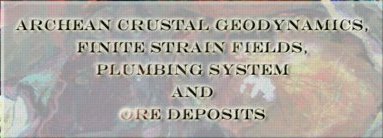| Slide 1 of 20 |
| Slide 1 of 20 |
 Patrice F. Rey Now we have an idea on how the present-Earth works, let's have a glance at one of the important issue for the Earth history: The Geodynamic of the Primitive Earth. The Archaean era extends from the age of the oldest rock on Earth (about 4.03 Ga) to 2.5Ga. This long period of time covers no less than a third of the Earth's history and was a period where fundamental processes took place. 100% of the ocean and 80% of the continent crust were created at that time. The Archaean was the craddle of life (some of the oldest trace of bacterial activities were found in the Pilbara (WA) in 3.4 Ga year old rocks). There is a vigorous controverse amongst Earth Scientists centered on the relevance of plate tectonic theory to Archaean time. Some scientists believe the geodynamic of the primitive Earth was not significantly different than that of the modern Earth, while others argue that plate tectonics could not have operate in the Archaean and that processes particular to the Archaean did exerced a major role of the structuration of the continental lithosphere. The aims of this lecture is to offer a glimpse at a cutting edge issue in tectonics. You will see that the understanding of small scale structures seen at the surface of Archaean craton (including ore deposits) can only be understood if their relationships with large scale processes is understood. |